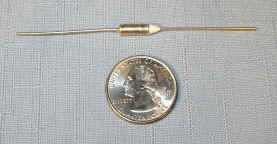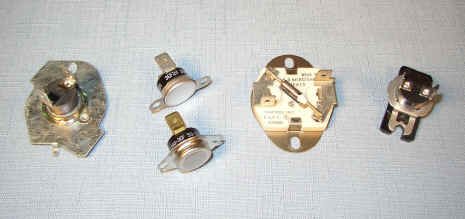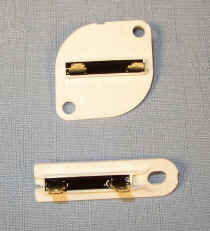|
The
DRSNews
September/October 2006
Note: Due to some recent health issues, I've fallen way behind and
have to skip publishing a separate October issue this year.
'Hope to get back to our normal schedule next month!
Published by subscription only, by Dave’s Repair Service
©2006 All Rights Reserved
In this issue:
* Your Dryer’s Thermal fuse:
What it does, How to Test it, Where to Find it
* DRSNews Back Issues Available to Subscribers
* I get a ton of questions from folks with ‘no heat’ dryers, and thought I’d
tell you about the second most common cause of the problem – the thermal fuse (actually, these days, I think the numbers of open elements and blown thermal fuses are running about even in electric dryers).
(Note: to satisfy the legal guys, I have to first point you toward my 'disclaimer' when providing this kind of information):
My Disclaimer
To be fair, this failure’s usually not the thermal fuse’s fault, but the real cause lies in a partially (or completely) clogged dryer vent system. In those cases, the thermal fuse is just doing the job it was designed for.
Thermal fuses, or thermal cutoffs, are small electrical temperature sensitive ‘switches’ designed to interrupt electrical current flow when heated to
their specific rated 'trip' temperature.
Unlike a thermostat, which automatically resets itself when the temperature drops, thermal fuses are more like their cousins, electrical fuses, another single-use type device that can’t be reset and must be replaced when it fails or is triggered.
In addition to their legally mandated application in modern clothes dryers (since the 1980’s), thermal fuses are used as safety devices in other heat-producing appliances like coffee makers and hair dryers. They disconnect the flow of current to the heating element in case of malfunction (such as a defective thermostat or clogged dryer vent) that allows the temperature to rise to dangerous levels, possibly starting a fire.
|

|
|
Small appliance style thermal fuse |
Unlike electrical fuses or circuit breakers, thermal fuses only react to excessive temperature, not excessive current, unless the excessive current is high enough to cause the thermal fuse itself to heat up to the trigger temperature.
In a clothes dryer, the term ‘thermal fuse’ usually refers to the device used in the heating circuit, directly controlling the dryer’s heat source. When you hear ‘thermal cutoff’, it normally refers to a similar little device installed in the motor circuit, and that one shuts down the motor in an over-temperature condition.
(One exception to this generality is most Whirlpool – built gas dryers. Just to keep life interesting, the Whirlpool system uses the thermal device that we commonly call the ‘cutoff’ to control the gas ignition system, instead of a thermal ‘fuse’)
The good news is, these thermal devices are one of the easiest components in the dryer to test. Being just a simple ‘on/off’ switch that happens to be sensitive to a specific temperature, they’re either closed (good) or open (bad).
To test one, leave it in the dryer, power the dryer down, bypass the thermal device, and power up and run the dryer with it bypassed or jumpered. If the dryer now heats, you immediately know it’s open and should be replaced.
Please, please note this is only to be done temporarily to test the thermal.
|

|
|
Here are several common dryer thermal fuses.
L to R, they're: Whirlpool/KM, two Frigidaires, older Speed Queen, and
GE/Hotpoint |
I’ve seen a lot of homes saved from fire by these simple little devices, so I must emphasize this. Resist the temptation to leave it bypassed and not replace it. It’s one device that has to be there, and it just might save your house from fire.
So how do I locate my thermal fuse, you ask? Well, that depends on which brand dryer you own.
Whirlpool – made 29-inch (wide) machines (Most Kenmores, Kitchenaid, Roper, Estate): you’ll find the thermal fuse ‘reading’ the heating element’s temperature from the side of the ‘can’ where the element lives, in the back of the dryer. This one’s the device mounted highest on the side of the ‘can’, directly above the safety thermostat, which is down near the element leads.
Note: on WPL/KM 29-inch GAS models, keep in mind that the thermal device that controls heating (it’s the ‘thermal cutout’ and controls the motor in electric models) is in the back, and looks different. That one’s a skinny little fellow, about 1-1/4 inches long by approx ¼ inch wide, mounted to the blower housing in back, next to the control tstat(s). Can be bypassed to test just like the others, though.
|

|
|
Here are two popular thermal cutouts |
Whirlpool/KM 27-inch (wide) dryers: Mounted on the side of the element
‘can’, accessed from the front. The thermal’s furthest back on the
can, behind the safety tstat. Easy to get to: use a putty knife in its top
edge to release the bottom front panel, and swing the panel down. It’s
easiest to remove the heat shield over the front of the element to get a
little extra room to work.
Frigidaire – built (Frig, Westinghouse, Tappan, Gibson, Kelvinator): most newer models tuck theirs above the large round element ‘pan’ behind the drum. There’re often tight ones to get to, but if you pop the cabinet top (a putty knife pushed into the front, on each side, releases the top clips) and swing it up out of the way, you’ll see it back there, next to the safety tstat. It’s the smaller round device, and its wire terminals are usually the smaller 3/16 inch ones.
GE/Hotpoint: Pre ‘Profile’ models mounted their thermal in the same basic location as Frigidaire.
Maytag-built ‘Maycor’ units (Norge, Magic Chef, Admiral, Crosley, etc): Another somewhat tough one to access, this one’s tucked below the compact heating element’s terminals, and you’ll need to raise the cabinet top to get to it, too. I often have to use long-nosed pliers to reach my alligator-clip jumper down in there to jumper these. Tight spot. With the top raised, it’s easy to run the dryer and watch for the element to glow with the thermal jumped on these. The good news is, to get to this one you only have to pull the dryer out a short distance so the top has room to swing upward. No need to access anything in the back.
Note: most newer Maytag ‘Dependable Care’ machines (the last ‘real’ Maytags <grin>) have their thermal fuse on the side of their element can, similar to the Whirlpool 27 inchers. Very similar to the Speed Queen front panel: two screws are removed from the bottom, and it’s swung upward and unhooked to get access to the element area.
Speed Queen and Amana: Removing two screws at the bottom front of these cabinets allow the front to swing out, then the top clips to unhook. With the front off, you’ll see the rectangular element can in the back, on the left side. The thermal’s mounted to the front, flat surface of the element can, and the wires are easily reached to jumper. These can be run briefly with the front panel off to test, but don’t run them very long that way if the element’s heating, because there won’t be enough airflow through the element that way, and you can quickly burn the element (or thermal fuse!) out.
It's always a good idea to
replace both the thermal fuse AND safety thermostat when the fuse is found
open. In fact, most manufacturers supply these in kits that include both
parts. The thinking is, if the thermal's blown, it's a pretty fair
bet that the safety tstat's been doing a LOT of cycling, and is most
likely really stressed.
One final note on these: if you find your thermal fuse (or element) open, before replacing it, be sure to check the airflow out your dryer’s vent system. Even though these devices do ‘wear out’ with age, poor airflow’s the #1 cause of failure of these devices, and if your vent’s partially clogged, a new thermal won’t last very long, but will do its job again, and leave you
’cold’ (a new element won't last long if the vent's clogged,
either).
Whirlpool recently introduced a simple little
airflow test kit for their dryers that makes this an easy thing to test. Works on both their 29 and 27 inch models, and is very inexpensive. I recommend those if you own a Whirlpool-built machine. You’ll find them on the ‘parts and tools’ page of the website.
* The number of DRSNews back issues has grown nicely since the first
issue back in May 2002, so I’ve decided to restrict access to them to everyone but you loyal, longsuffering subscribers.
You’ll notice that the website link to back issues is ‘dead’, with the ‘live’ link included only in each issue of the newsletter. Nothing else will change, with your current issue still being delivered to your inbox in text form and also available online in html, with more pictures, graphics, etc.
I don't have all of them
up yet, but I'm working on posting the remaining back issues for you as fast as I can.
***
As always, if you have any topics you’d like to see discussed here or covered in an online article, let me know and I’ll do my best to oblige. And don't forget those testimonials! Many thanks if you've already sent yours in!
May God richly bless you, and may He continue to have mercy on America.
Dave Harnish
Dave’s Repair Service
New Albany, PA
drs@sosbbs.com
www.DavesRepair.com
‘Set your goals high, and shoot for the moon. Even if you miss, you’ll land among the stars!’
Phil 4:1
Parts orders for items not posted here on the website
(One of the largest appliance parts inventories in the world!):

Copyright 2006, www.DavesRepair.com
, All Rights Reserved
This newsletter may be reprinted and distributed freely, but only
in its entirety, including this message.
|